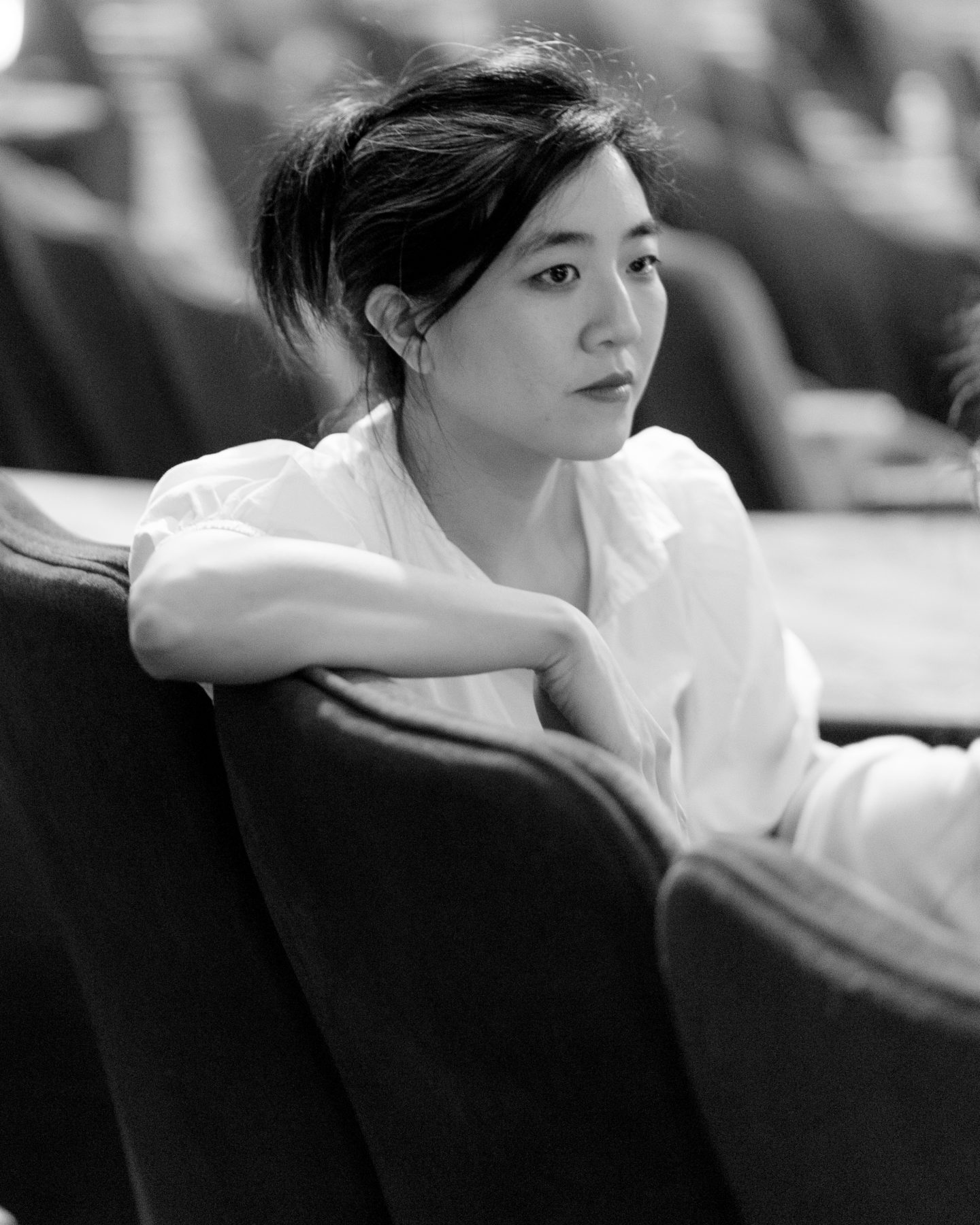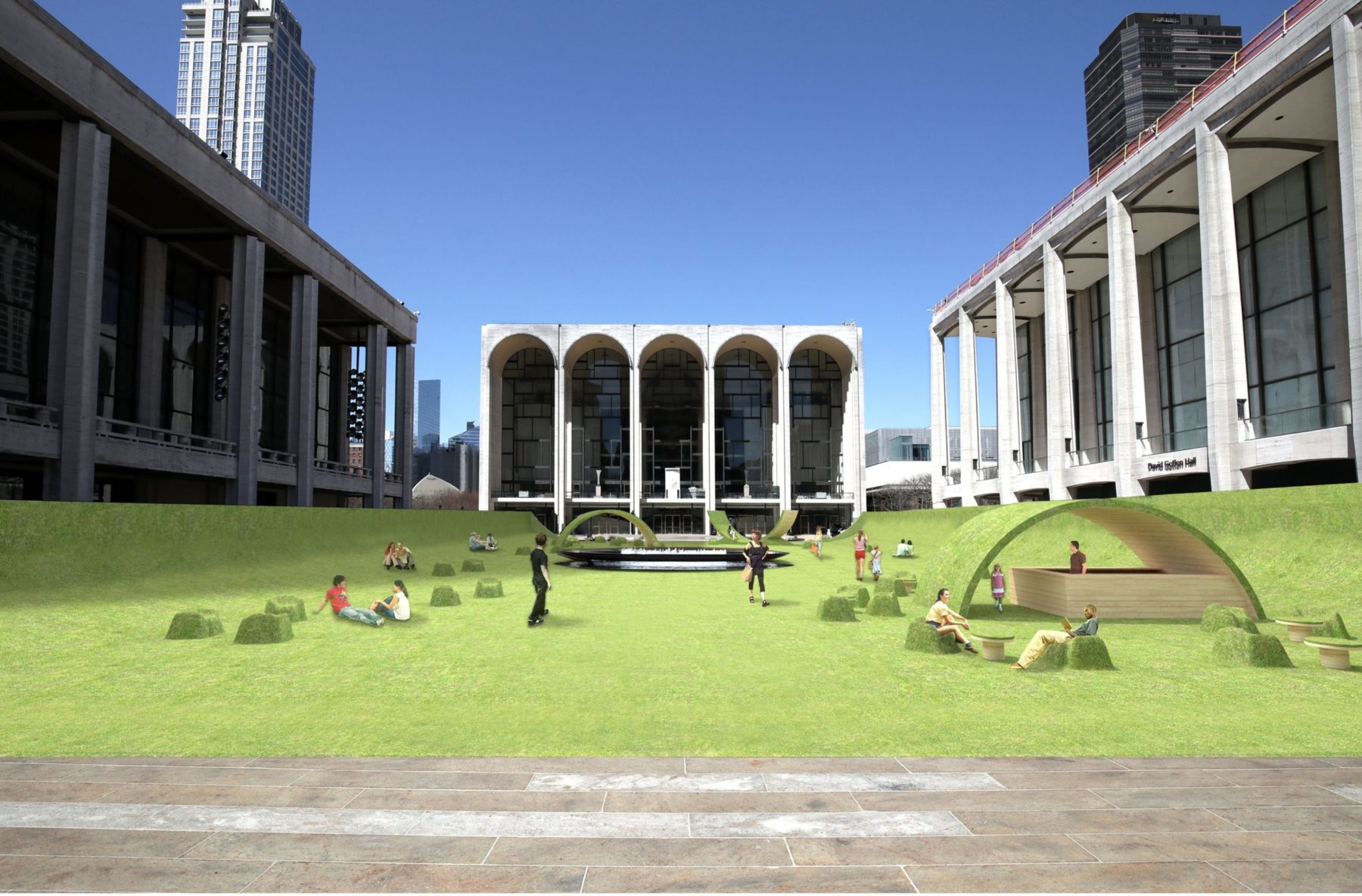For more than a year, Lincoln Center’s programming has been remodeled for online audiences at home. But as the vaccination effort accelerates, this New York institution is about to launch socially distant in-person performances outside, starting May 10, 2021. The Restart Stages initiative reimagines how to use public spaces for the performing arts. Lincoln Center commissioned set designer and MacArthur Fellow Mimi Lien to transform the 14,000 square foot concrete Josie Robertson plaza into a built environment called “The GREEN.” The space will offer pop up performances throughout the summer and fall, snacks and a book borrowing program created in partnership with the New York Public library.
In this conversation with CNS reporter Lily Lopate, Mimi Lien explains the process of designing The GREEN—her first on this public scale—and, why built environments can encourage social interaction and how she found her vision as an artist, at the intersection between architecture and dramaturgy.

How did the project with Lincoln Center start? As a theatrical set designer, I have worked at Lincoln Center Theater a few times. As a result of these connections, I was invited to participate in a brainstorming session that Lincoln Center hosted in February 2021. It was about how to reactivate audiences and make their outdoor campus more inclusive. I was very interested to participate because I’ve thought a lot about the built environment and have had a desire for my work to grow into the public realm.
What kinds of ideas were exchanged during that meeting? Some people in attendance identified certain formal qualities they noticed about the plaza like the rigid architecture, the concentric circle pattern on the paving stones. But what I noticed was that there was nowhere to sit! No seating and no benches. Even the ring around the fountain – you’re not supposed to sit on it.
I’ve definitely sat there! So that became the genesis for The GREEN? Yes, I just suddenly had the idea about grass—because it would immediately transform this surface of hard pavement into a place you could sit anywhere.
So, after the idea was approved, how long did you have to design it? I had to work very quickly like two weeks to come up with the preliminary concept. And then I had maybe another two weeks to refine it.
That’s a fast turnaround for institutional level programming. I think of Lincoln Center as 10 years ahead in their planning. Well, that’s what’s exciting. I think that that preconceived idea of Lincoln Center planning years in advance is gradually changing – at least Restart Stages is actively trying to respond to the moment.
As you were designing, how did you imagine people would engage with the space? I believe if something exists outside, it’s performing all the time. Set design is involved with the perception of the audience. So, I’m always thinking about the relationship between the audience and the performance. To create the space, I decided to make the green grass curve up at either end. I call it a halfpipe. A flat piece of grass just didn’t contain the energy. So, I was conceiving of it as both a green space and performance space.
The Plaza is also a vast open space. So right away, I wanted to create little islands of intimacy where people could have a quiet conversation. Like a small hideaway within this big lawn.
What gave you inspiration as you designed these ‘little islands of intimacy?’ I considered a lot of options in terms of what design element would serve best. And then, to be honest, I looked at the facade of the Metropolitan Opera and it has these columns that go up to arches at the top. I thought that would be great to have an element that relates to the surrounding structure, to contextualize it. I said what if we took, like, these arches and just placed them around the green? One is right side up, the other is upside down and becomes kind of a playful structure that you make your own.
Can you talk about the materials specifically used? And is it real grass? So, the arches are bent steel covered with a plywood surface and then the grass is applied over that.
I totally wanted it to be real grass. That was the original invitation to sit down and have this kind of tactile, visceral experience. But after talking to landscape specialists, I learned that real grass would be challenging to maintain. So, I looked at artificial samples and decided to go with SYNLawn. It’s a soy-based and eco conscious product.
Ingenuity can stem from limitations. How did you work around the Lincoln Center construction? There was a practical consideration to the design because there’s a chain link fence along the plaza. I confess, that slope on the green was also an elegant design solution to hide the construction. But I knew from the start, I wanted the design to be visible from the street level. I wanted greenery to start on the steps to the plaza, like a theatrical entrance into the space.

Built environments are more visible across the city now as institutions repurpose spaces and people spend more of the year outside. Could you see this outdoor stage set up becoming a longer-term space? I hope it’s something that will continue. If anything, the move outdoors is making people more visible to each other. Bringing people outside to enjoy cultural arts is intrinsic to the social infrastructure. A designated site can build community. Think of when people bring their kids to the same neighborhood playground, parents start to form a relationship. Community can be knit from works of physical infrastructure, but it only happens within spaces that are intentional about forming those social relationships.
Have you considered doing other large scale urban projects like this? I do dream about it! I love the idea of designing an environment that spans the course of several seasons. Or in an indoor theater setting, have an entire season-worth of performances on the same set. I love that notion of multiple performances happening in one environment.
Actually, the premise of an extended set reminds me of an Austrian opera festival in the town of Bregenz, where a set is built on a lake every two years. The performance happens in the summer but during the winter the set becomes a public sculpture in the middle of the lake.
You once said set design gives you a “laboratory for creating spaces that dictate human behavior.” COVID-19 has arguably dictated how we move and relate to each other, so I’m wondering with The GREEN, if that played a role? My greatest hope is that it encourages social infrastructure. A place that can bring people together –within our six-foot guidelines. As for thinking about interpersonal relationships in space, it’s a theme in a lot of my work. For example, in Natasha, Pierre & the Great Comet of 1812, that whole design was meant to bring strangers together at one small table. So, even a well-placed sitting area can foster a convivial experience.
I’m hoping The GREEN has that on a macro level. The arches are meant to encourage social interaction. And the library reading corner too, if two people borrow books at the same time there’s a moment of connection which is really important in this isolated time.
You’ve talked about architecture being an influence in your vision, but you also draw from the language of dramaturgy. What words are most essential to you? Ooh the word that comes to mind is “container.” I’m creating a container for the performance. And that can include the audience. The size and scale and atmosphere of that container determines what the relationship between the audience and the performance will be.
Theater at its best is not a one-way relationship. It’s very much an alive dynamic. The audience and the performers, the text, music, visual spatial environment, all of those elements are working together to create an event. I’m creating the physical and visual container for the event. My job is creating the environment for those connections to take shape. There’s a synergy too. Even if the audience is watching what’s on stage, there’s still an exchange of energy.
That’s a great point, that there is a palpable kinetic energy. Right and before kinetic energy, it’s potential energy. There’s a conversion of energy that happens for it to make an impact. With every performance you hope to be moved. I really feel like it engages the body of the viewer in space. That’s why I love non-traditional spaces, because there’s something taken for granted in a typical proscenium house where it’s ok for the audience to sit back passively. And that set up doesn’t have as much potential for affecting the audience in a really visceral and emotional way.
Q&A has been condensed from a conversation on April 26, 2021.
About the author(s)
Lily Lopate is pursuing a master’s degree at Columbia Journalism School. A native New Yorker, she received a bachelor’s degree in English and Philosophy from Bryn Mawr College and also studied at St. Andrews University in Scotland. Prior to journalism, she worked at HarperCollins Publishers and Finn Public Relations. Her work has appeared in the anthology Every Father's Daughter (McPherson & Co), People Magazine, HoneySuckle Magazine, Medium and Mr. Beller's Neighborhood. She’s most interested in cultural hubs and the characters inside them, and you can find her covering arts, culture, food, metro, business and community issues.
Connect with Lily Lopate via Twitter: @Lily Lopate or lel2165@columbia.edu



